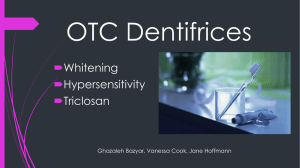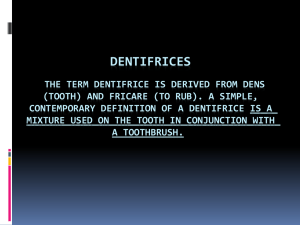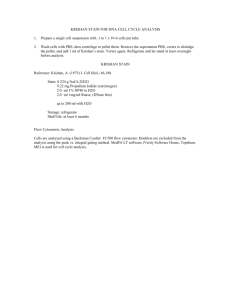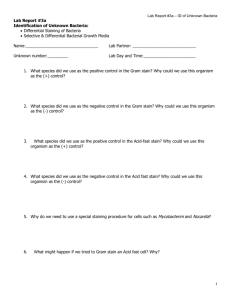Abrasion, Polishing, and Stain Removal Characteristics of
advertisement
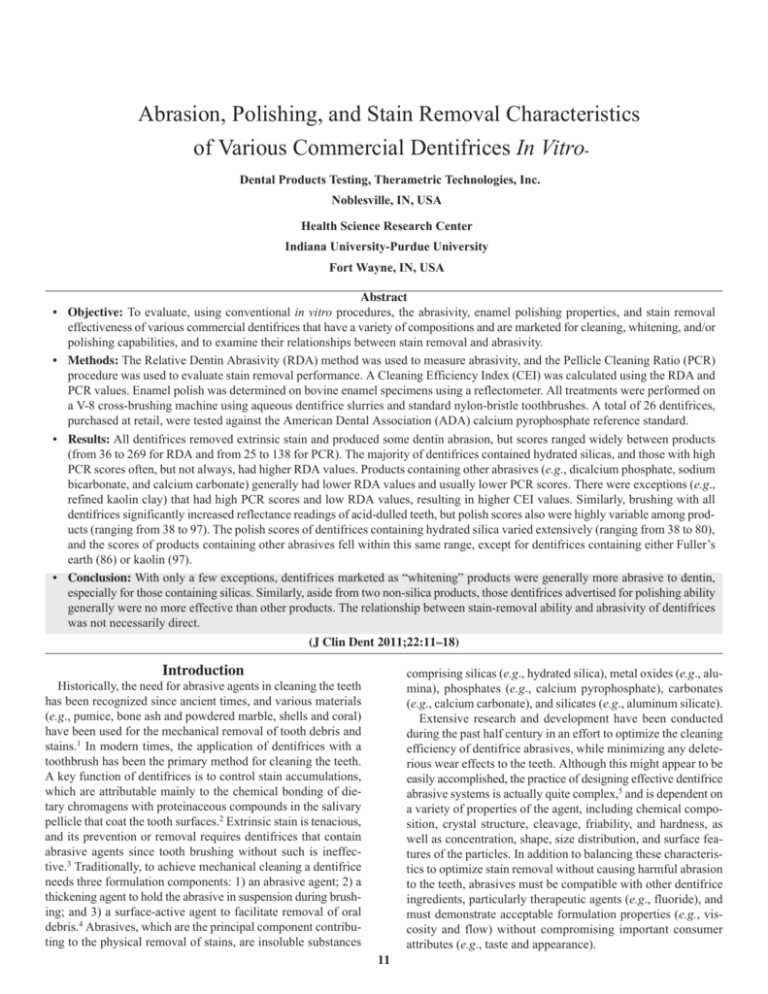
Abrasion, Polishing, and Stain Removal Characteristics of Various Commercial Dentifrices In VitroDental Products Testing, Therametric Technologies, Inc. Noblesville, IN, USA Health Science Research Center Indiana University-Purdue University Fort Wayne, IN, USA Abstract • Objective: To evaluate, using conventional in vitro procedures, the abrasivity, enamel polishing properties, and stain removal effectiveness of various commercial dentifrices that have a variety of compositions and are marketed for cleaning, whitening, and/or polishing capabilities, and to examine their relationships between stain removal and abrasivity. • Methods: The Relative Dentin Abrasivity (RDA) method was used to measure abrasivity, and the Pellicle Cleaning Ratio (PCR) procedure was used to evaluate stain removal performance. A Cleaning Efficiency Index (CEI) was calculated using the RDA and PCR values. Enamel polish was determined on bovine enamel specimens using a reflectometer. All treatments were performed on a V-8 cross-brushing machine using aqueous dentifrice slurries and standard nylon-bristle toothbrushes. A total of 26 dentifrices, purchased at retail, were tested against the American Dental Association (ADA) calcium pyrophosphate reference standard. • Results: All dentifrices removed extrinsic stain and produced some dentin abrasion, but scores ranged widely between products (from 36 to 269 for RDA and from 25 to 138 for PCR). The majority of dentifrices contained hydrated silicas, and those with high PCR scores often, but not always, had higher RDA values. Products containing other abrasives (e.g., dicalcium phosphate, sodium bicarbonate, and calcium carbonate) generally had lower RDA values and usually lower PCR scores. There were exceptions (e.g., refined kaolin clay) that had high PCR scores and low RDA values, resulting in higher CEI values. Similarly, brushing with all dentifrices significantly increased reflectance readings of acid-dulled teeth, but polish scores also were highly variable among products (ranging from 38 to 97). The polish scores of dentifrices containing hydrated silica varied extensively (ranging from 38 to 80), and the scores of products containing other abrasives fell within this same range, except for dentifrices containing either Fuller’s earth (86) or kaolin (97). • Conclusion: With only a few exceptions, dentifrices marketed as “whitening” products were generally more abrasive to dentin, especially for those containing silicas. Similarly, aside from two non-silica products, those dentifrices advertised for polishing ability generally were no more effective than other products. The relationship between stain-removal ability and abrasivity of dentifrices was not necessarily direct. (J Clin Dent 2011;22:11–18) Introduction comprising silicas (e.g., hydrated silica), metal oxides (e.g., alumina), phosphates (e.g., calcium pyrophosphate), carbonates (e.g., calcium carbonate), and silicates (e.g., aluminum silicate). Extensive research and development have been conducted during the past half century in an effort to optimize the cleaning efficiency of dentifrice abrasives, while minimizing any deleterious wear effects to the teeth. Although this might appear to be easily accomplished, the practice of designing effective dentifrice abrasive systems is actually quite complex,5 and is dependent on a variety of properties of the agent, including chemical composition, crystal structure, cleavage, friability, and hardness, as well as concentration, shape, size distribution, and surface features of the particles. In addition to balancing these characteristics to optimize stain removal without causing harmful abrasion to the teeth, abrasives must be compatible with other dentifrice ingredients, particularly therapeutic agents (e.g., fluoride), and must demonstrate acceptable formulation properties (e.g., viscosity and flow) without compromising important consumer attributes (e.g., taste and appearance). Historically, the need for abrasive agents in cleaning the teeth has been recognized since ancient times, and various materials (e.g., pumice, bone ash and powdered marble, shells and coral) have been used for the mechanical removal of tooth debris and stains.1 In modern times, the application of dentifrices with a toothbrush has been the primary method for cleaning the teeth. A key function of dentifrices is to control stain accumulations, which are attributable mainly to the chemical bonding of dietary chromagens with proteinaceous compounds in the salivary pellicle that coat the tooth surfaces.2 Extrinsic stain is tenacious, and its prevention or removal requires dentifrices that contain abrasive agents since tooth brushing without such is ineffective.3 Traditionally, to achieve mechanical cleaning a dentifrice needs three formulation components: 1) an abrasive agent; 2) a thickening agent to hold the abrasive in suspension during brushing; and 3) a surface-active agent to facilitate removal of oral debris.4 Abrasives, which are the principal component contributing to the physical removal of stains, are insoluble substances 11 12 The Journal of Clinical Dentistry Significant advances by dentifrice manufacturers during this period have resulted in currently available multi-functional toothpastes that deliver various therapeutic and cosmetic benefits, including treatment of malodor, caries, gingivitis, dental plaque, dental calculus, demineralization, and dentinal hypersensitivity.6,7 Nevertheless, in spite of this progress, the primary reason people use toothpastes is to improve tooth appearance by cleaning the teeth and reducing unsightly stains.5 Moreover, in recent years there has been an increase in interest by the general public in oral esthetics, which has stimulated the development of new technologies for whitening teeth. This has led to the widespread use of bleaching systems, such as peroxide gels and strips, for treating intrinsic tooth discoloration and to whitening dentifrices for removing and/or preventing extrinsic stain accumulations. In addition to abrasives, two chemical approaches have been taken with dentifrice formulations for the purpose of preventing and/or removing extrinsic tooth stains: 1) surface-active agents that reduce stain molecule adhesion or desorb already attached stain molecules (e.g., surfactants, enzymes, chelators, and calcium phosphate builders); and 2) bleaches/oxidizing agents that reduce stain by oxidizing colored unsaturated compounds into uncolored carboxylic acids and alcohols (e.g., stabilized hydrogen peroxide and carbamide peroxide).5-7 While all dentifrices contain common detergents (e.g., sodium lauryl sulfate or sodium N-lauroyl sarcosinate), dentifrices have been introduced during the past few years with other chemical agents that promote extrinsic stain control (e.g., pyrophosphate and polyphosphates).8 Dentifrices containing peroxide have utilized dual-phase systems that combine paste and gel when extruded onto the toothbrush immediately before use.9 Another characteristic of dentifrices that has not received as much attention is polishing ability. Like stain removal and abrasivity, the polishing ability of a dentifrice is a physical phenomenon associated with the abrasive system. The concept of high enamel luster is important for two reasons. First, from a cosmetic viewpoint, an increase in luster contributes to the esthetics of the dentition, and improved surface smoothness is conducive to a feeling of oral cleanliness. Also, more highly polished enamel appears whiter than duller enamel.10 Second, and more importantly, smooth highly polished tooth surfaces are less receptive to the accumulation and retention of dental plaque, calculus, and extrinsic stain, and the concomitant oral disease processes. Many studies have demonstrated that rough, unpolished tooth surfaces facilitate the formation and retention of dental plaque, oral debris, calculus, and extrinsic stain.11-14 For example, initial bacterial colonization of enamel surfaces starts in surface irregularities (e.g., pits, scratches, defects), and preferential retention occurs on rough surfaces where bacteria are more protected from shear forces.15,16 In summary, a dentifrice should have the ability to remove extrinsic stains effectively without resulting in unnecessary de leterious abrasion to the teeth. Additionally, as a means of inhibiting dental accumulations (i.e., stains, plaque, and calculus), a dentifrice should impart a smooth, highly polished surface to the teeth, thereby contributing not only to oral esthetics, but also to a concomitant improvement in oral health. Vol. XXII, No. 1 The objective of this investigation was to evaluate dentifrices that are currently marketed for advanced cleaning, whitening, and polishing properties in an effort to determine if these products really provide the benefits as advertized. Because there are a large number of dentifrice products on the market and the formulations undergo frequent modifications, the products selected for evaluation were not comprehensive, but rather representative of those available mainly in the US. Materials and Methods Dentifrice Samples A total of 26 commercial dentifrice products were purchased in 2008 through local retail outlets or ordered online. Table I provides information obtained from the packaging labels, including tradenames, manufacturers, putative abrasive systems, and other ingredients that could possibly affect the test parameters. These comprise, for example, minor insoluble ingredients and various phosphates and other chemicals that may have surface conditioning properties. Detergents and surfactants also could possibly influence stain removal, but because all the dentifrices contained these, they were not included. In addition, Table I has dentifrice package label claims concerning stain removal, whitening, abrasion, and polishing that are relevant to this investigation. Stain Removal Procedure The Pellicle Cleaning Ratio (PCR) procedure was a modification and improvement of the laboratory method described by Stookey, et al.17 Squares (4 mm) of enamel were cut from bovine permanent incisors, and were embedded in clear, self-curing denture acrylic to provide square blocks (1.5 cm) with the labial surface exposed. The labial surfaces of the enamel squares were ground flat using a model trimmer to allow uniform instrumental color readings. The surface was smoothed on wet 400 grit emery paper until all grinding marks were removed, and then the flattened surface was highly polished with alumina. The finished specimens were examined under a dissecting microscope, and discarded if surface imperfections were observed. Prior to staining, the specimens were etched for 60 seconds in 0.2M HCl, rinsed with water, and etched again for 60 seconds with 1% phytic acid. After a final water rinse, the specimens were attached to a staining apparatus, constructed to provide alternate immersion into a staining broth and air-drying of the specimens. The apparatus consisted of an aluminum platform base which supported a Teflon® rod (3/4 inch diameter) rotating at a constant rate (1.5 rpm). The tooth specimens, attached by plastic screws spaced at regular intervals along the length of the rod, rotated through the broth in a removable plastic trough (300 ml capacity). The staining broth was prepared as described previously17 by adding instant coffee, instant tea, red wine, and porcine gastric mucin to sterilized trypticase soy broth, which was then inoculated with a 24-hour Micrococcus luteus bacterial culture. The apparatus, with the enamel specimens attached and the staining broth in the trough, was incubated at 37°C with the specimens rotating continuously through the staining broth and air. The broth was replaced once daily for ten consecutive days. With each broth change, the trough and specimens were rinsed and Vol. XXII, No. 1 The Journal of Clinical Dentistry 13 Table I Dentifrice Product Information and Ingredients No. Tradename 1 Aquafresh Extreme Clean 2 Aquafresh White & Shine 3 Arm & Hammer Dental Care Advanced Cleaning 4 BlanX Non-abrasive Whitening Manufacturer GlaxoSmithKline GlaxoSmithKline Church & Dwight Abrasive System Hydrated silica Hydrated silica Sodium bicarbonate Other Relevant Ingredients Iron oxide Disodium Phosphate, Mica No other relevant ingredients Guaber, UK Silica Arctic lichen (Cetraria islandica) BriteSmile, Inc Colgate-Palmolive Colgate-Palmolive Colgate-Palmolive Hydrated silica Dicalcium phosphate Hydrated silica Hydrated silica Colgate-Palmolive Procter & Gamble Procter & Gamble Procter & Gamble Hydrated silica Hydrated silica Hydrated silica, Na bicarbonate Hydrated silica 13 Crest Vivid White Procter & Gamble Hydrated silica Pentasodium triphosphate Tetrasodium pyrophosphate Tetrasodium pyrophosphate Na phosphates, PVM/MA, Na-Mg silicate, Hydrogen peroxide PVM/MA copolymer Sodium phosphates Tetrasodium pyrophosphate, Sodium carbonate Na hexametaphosphate, Trisodium phosphate Na hexametaphosphate 14 15 16 17 Dentisse, Inc GoSmile, Inc Jason Natural Products Church & Dwight Refined kaolin clay Hydrated silica Ca carbonate, Silica Hydrated silica, Na bicarbonate Na bicarbonate, Hydrated silica Bentonite clay No other relevant ingredients Na bicarbonate Hydrogen peroxide, phosphoric acid Tetrasodium pyrophosphate Johnson & Johnson Dicalcium phosphate Al hydroxide, Papain Johnson & Johnson Hydrated silica, Dicalcium phosphate Hydrated silica Al hydroxide, Papain 5 6 7 8 Brite Smile Colgate Cavity Protection Colgate Luminous Colgate Simply White 9 Colgate Total Whitening 10 Crest Cavity Protection 11 Crest Extra Whitening 12 Crest Pro-Health Package Label Claims Leaves teeth feeling clean, smooth and brighter Cleans and polishes for whiter, shinier teeth Low abrasion formula/Helps remove surface stains Cleans, protects and whitens/In-depth cleaning without abrasive effects Whiten teeth safely and effectively Cleans teeth thoroughly For strong, shiny, whiter teeth Twice the whitening action of ordinary whitening toothpaste Whitens teeth No relevant claims Polishes for natural whiteness/Whitens teeth by gently polishing away surface stains Whitens teeth by removing surface stains Whitens teeth by polishing away surface stains and acts to help prevent new surface stains Dentisse Natural Reflection Premium polishing and whitening GoSmile AM Whitening Whiten naturally Jason’s Powersmile Exclusive natural whiteners Mentadent Advanced Whitening Noticeably whiter teeth 18 Pearl Drops Triple Action Whitening 19 Rembrandt Complete 20 Rembrandt Intense Stain 21 Rembrandt Plus Gently cleans away surface stains/Safely polishes for whiter & brighter teeth/ See the whiteness, feel the shine Whitens beyond surface stains/Low abrasion formula won’t scratch enamel Deep cleans and whitens gently Church & Dwight Whitens teeth beyond surface stains without scratching enamel No relevant claims Removes stubborn stains without harmful bleaches or abrasives Johnson & Johnson 24 Tom’s of Maine Natural Contains calcium for clean teeth Tom’s of Maine 25 UltraBrite Advanced Whitening Whitens teeth Colgate-Palmolive 26 Umbrian Clay Whitening properties Fresh, Inc 22 Sensodyne Extra Whitening 23 Supersmile brushed with water to remove any loose deposits. On the eleventh day, the staining broth was modified by adding FeCl3.6H2O, and this was continued with daily broth changes until the stained pellicle film was sufficiently dark (L* score range 30–35). Then, the specimens were removed, brushed thoroughly with water, and refrigerated in a humidor until used. The amount of stain on the teeth was measured by taking color readings using a spectrophotometer with diffuse illumination/8° viewing angle and three mm aperture (Minolta CM-503i Spectrophotometer, Minolta Camera Co., NJ, USA). Measurements over the entire visible color spectrum were obtained before and after treatment using the CIELAB color scale.18 Stained enamel specimens were air-dried at room temperature for 30 minutes, and color measurements were made by aligning the center of the stained enamel square directly over the targeting aperture of the spectrophotometer. Three color readings using the L*a*b* scale were averaged for each specimen. GlaxoSmithKline Robell Research Hydrated silica Dicalcium phosphate, Na bicarbonate, Ca carbonate Ca carbonate, Hydrated silica Hydrated silica, Alumina Fuller’s earth Urea peroxide, Al hydroxide, Silica, Papain Na phosphate Ca peroxide, Na perborate No other relevant ingredients Tetrasodium pyrophosphate Sodium chloride The specimens were stratified into groups of 16, with each group having equivalent average baseline L*a*b* stain scores. The specimens were positioned on a V-8 mechanical crossbrushing machine19 equipped with soft, nylon-bristle toothbrushes (Oral-B® 35 Soft, Procter & Gamble, Cincinnati, OH, USA), adjusted to 150 g pressure on the enamel surfaces, and brushed with the dentifrice slurries (25 g dentifrice, 40 g deionized water) for 800 reciprocating strokes. The control abrasive, American Dental Association (ADA) reference material calcium pyrophosphate (Monsanto, St. Louis, MO, USA) was mixed in a 1:5 ratio with a 0.5% carboxymethylcellulose solution (CMC-7MF, Hercules, Inc., Wilmington, DE, USA). Test products were randomly assigned to machine positions until all products were tested at all positions twice. After the final color readings were made, the specimens were pumiced to remove all residual stain from the teeth, and color readings were repeated. This technique provided an inherent value for each specimen, representing the 14 The Journal of Clinical Dentistry maximum amount of stain that potentially could be removed by the test dentifrice. The difference between the pre-test and post-test readings for each color factor (L* a* b*) represents the ability of the test products to remove stain and whiten teeth. The overall change in stain was calculated using the following CIELAB equation:18 ΔE = [(ΔL*)2 + (Δa*)2 + (Δb*)2]1/2 The Pellicle Cleaning Ratio was calculated as follows:17 PCR = (Test sample ΔE ÷ ADA Reference sample ΔE) ⫻ 100 Dentin Abrasion Procedure The Relative Dentin Abrasion (RDA) procedure, which is based on the Radioactive Dentin Abrasion method of Grabenstetter, et al.,19 was used for the determination of dentifrice abrasivity. Root dentin specimens from human permanent teeth were irradiated in a neutron flux under controlled conditions outlined by the ADA.20 After mounting the specimens in dental acrylic blocks, they were preconditioned by brushing on the V-8 crossbrushing machine, equipped with ADA nylon-bristle toothbrushes, at 150 g pressure for 1500 strokes using a slurry consisting of ADA reference material in a 1:5 ratio with 0.5% CMC aqueous glycerin solution. Following preconditioning, tests were performed using the same parameters (150 g pressure and l500 strokes) in a sandwich design, in which each test dentifrice slurry (25 g/40 ml water) was flanked by the reference material slurries (10 g/50 ml 0.5% CMC). Test products were randomly assigned to machine positions until all products were tested at all eight positions. Aliquots (1 ml) were pipetted, weighed (± 0.01g) and added to scintillation cocktail (4.5 ml). The samples were mixed well, and immediately put on the scintillation counter for β-radiation detection. Following measurement, the net counts per minute (cpm) were divided by the weight of the sample to calculate a net cpm/g of slurry. The net cpm/g of the pre- and post-sample ADA reference material for each test slurry was calculated and averaged to use in the calculation of RDA (relative dentin abrasion) for the test material. The reference material was assigned a value of 100 and its ratio to the test material was calculated. As of 16 Aug 1999, a new lot of the ADA reference material, which is less abrasive than the original lots, has been used. This necessitates the addition of a 3.6% correction factor to the reference material cpm, permitting direct comparisons to historical data for this procedure. Cleaning Efficiency Index The Cleaning Efficiency Index (CEI), which was introduced by Schemehorn, et al.,21 was calculated according to the equation: CEI = (RDA + PCR – 50) ÷ RDA The CEI emphasizes the importance of good stain removal properties and low dentin abrasivity. The equation was based on clinical data that indicated a PCR value of at least 50 was needed to provide acceptable cleaning power (extrinsic stain removal).21,22 Enamel Polish Procedure The procedure for determining enamel polish was based on an earlier methodology in which acid-dulled teeth were mechanically Vol. XXII, No. 1 brushed with dentifrice slurries, and the degree of polish quantified with a reflectometer that measured the intensity of specular light reflected by the tooth specimens.23,24 The greater the intensity of light reflected from a specimen, the higher was the luster of the tooth, and hence the higher the numerical polish score. All evaluations were made with bovine permanent incisors, which are advantageous for testing due to their size and similar polishing properties to human teeth.25 The teeth were trimmed and mounted in self-curing dental acrylic blocks (2 cm) with the labial surface exposed. In order to permit reflectance measurements, a portion of the labial surface was ground using a watercooled surface grinder in such a way that a leveled area (approximately 1 cm in diameter) was produced parallel to the base of the mount. Tooth specimens were dulled prior to treatment by individually etching them with agitation (0.2M HCl) for 30 seconds, then thoroughly rinsing with distilled water, yielding a reflect ance score of 5 or less. Polish measurements were made using a glossmeter with a 60° operating angle and 5 mm ⫻ 10 mm aperture (NovoCurve™, Rhopoint Instrumentation Ltd., Bexhill-on-Sea, UK). Each enamel specimen was inverted on the glossmeter platform covering the opening, and read in Gloss Units (GU) as specified in American Society for Testing and Materials (ASTM D523). The glossmeter was calibrated to the manufacturer’s standard, and data were presented as the percentage between 0 (no reflectance) and 100 (white carrara glass standard).24 The specimens were positioned on a V-8 mechanical crossbrushing machine equipped with soft, nylon-bristle toothbrushes adjusted to 300 g pressure on the enamel surfaces, and brushed with the dentifrice slurries (25 g/40 g water) for 2000 reciprocating strokes. The control abrasive, ADA reference material calcium pyrophosphate, was mixed in a 1:5 ratio with a 0.5% CMC-7MF solution. Test products were randomly assigned to machine positions until all products were tested at all eight positions. Data Analysis Data from the three test methods were averaged for each of the 26 dentifrices tested for the following numbers of replicates: PCR (N = 16); RDA (N = 8); and enamel polish (N = 8). Because there were too many samples to perform meaningful multiple comparison tests, repeated t-tests were carried out for each test method in an effort to establish approximate differences in mean values between dentifrices that were statistically significant (p < 0.05). Results The data from each of the testing procedures (i.e., PCR, RDA, and polish) are provided in Figures 1–3. In each figure, the data bars are ranked in ascending or descending order according to the mean values obtained for each product with the specific testing procedure. Also, in each figure, the data for the calcium pyrophosphate reference standard is provided at the top as the first bar above all the dentifrice products. Figure 1 represents a composite summary of stain removal data obtained using the PCR procedure for all 26 dentifrices. The Vol. XXII, No. 1 The Journal of Clinical Dentistry 15 Figure 1. Pellicle Cleaning Ratio (PCR) data of commercial dentifrices ranked in order from lowest to highest stain removal. Dentifrices are labeled by tradename and identification number from Table I. Lengths of bars represent means; error bars show standard errors (n = 16). Figure 2. Relative Dentin Abrasion (RDA) data of commercial dentifrices ranked in order from highest to lowest abrasivity. Dentifrices are labeled by tradename and identification number from Table I. Lengths of bars represent means; error bars show standard errors (n = 8). 16 The Journal of Clinical Dentistry Vol. XXII, No. 1 Figure 3. Enamel polish data of commercial dentifrices ranked in order from lowest to highest level of luster. Dentifrices are labeled by tradename and identification number from Table I. Lengths of bars represent means; error bars show standard errors (n = 8). Figure 4. Cleaning Efficiency Index (CEI) data of commercial dentifrices ranked in order from lowest to highest values based on the equation in the text. Dentifrices are labeled by tradename and identification number from Table I. Vol. XXII, No. 1 The Journal of Clinical Dentistry amount of stain removed varied extensively between dentifrices, with PCR values ranging from a very low 25 for a silicacontaining dentifrice (Product 4) to a high of 138 for a hydrated silica/alumina system (Product 25). The relative dentin abrasion values for the various dentifrices are summarized in Figure 2. Similar to the PCR data, a wide range of dentin abrasion values was found during the evaluation of the different products, with RDA values as low as 36 for Product 4 to a high of 269 for a dentifrice with a hydrated silica abrasive (Product 5). It is noteworthy that this variation existed between dentifrices that contained different abrasive systems, but it also occurred between dentifrices that contained the same type of abrasive, namely hydrated silica. The results of the testing of the same 26 dentifrices for enamel polishing properties are assembled in Figure 3. All products increased the luster of the acid-dulled teeth, but a wide range of polishing abilities was observed from a relatively poor reflectance percentage of 38 for two hydrated silica-containing dentifrices (Products 21 and 22) to a very high value of 97 for a dentifrice with a refined kaolin abrasive agent (Product 14). With values of 80, two dentifrices containing hydrated silica (Products 11 and 25) polished moderately well, as did another containing Fuller’s earth (Product 26) with an average value of 86. The CEI values that were calculated from the PCR and RDA data are presented in Figure 4, and range from just 0.31 for a silicacontaining dentifrice (Product 4) to a high of 1.78 for a refined kaolin-containing dentifrice (Product 14). The four dentifrices that were the most effective at removing stain were also among the most abrasive (Products 2, 5, 7, and 25), which decreased their CEI values. The products with the highest CEI values (e.g., Products 14, 19, and 20) had moderate to high PCR scores, but relatively low RDA scores of less than 90. Discussion An ideal dentifrice should provide optimum cleaning (i.e., extrinsic stain removal) and polishing with minimum abrasion to the dental hard tissues (viz. cementum, dentin, and enamel). Maximum stain removal ability and low abrasivity are diametric opposites, as are high cleaning and high polishing. Thus, it is inevitable that some concessions must be made in order to achieve a suitable compromise, a fact that accounts for the large differences in stain removal, polishing, and abrasion properties of the various abrasive agents used in commercial dentifrices currently available to the public. The balance between extrinsic stain removal and abrasivity properties of dentifrices has been investigated and debated for a very long time, but there is general consensus with the statement by Kitchin and Robinson26 more than 60 years ago that, “One should use only as much abrasion as necessary to clean one’s teeth.” The challenge, of course, is in defining what is necessary. The results of this investigation are in agreement with earlier reports17,27,28 that generally there is moderate correlation between in vitro cleaning effectiveness and abrasiveness to dentin for various toothpastes, but RDA values are not always predictive of clinical stain removal.29 Still, it is very relevant to this investigation that both the RDA test and the PCR method correlated linearly with cleaning power (i.e., stain removal) in a collaborative 17 clinical study using three different grading methods that evaluated dentifrices with three different levels of abrasivity.21,22,30 The association between the RDA test and in vivo cervical/ dentinal abrasion is not well defined because of the large number of hard-to-determine variables and the near impossible difficulty conducting such clinical trials. In situ testing using tooth sections mounted in dentures may provide useful information31 since it encompasses the contribution of the salivary pellicle,32 but the etiology of this condition is likely a combination of many factors besides dentifrice abrasivity, including tooth brushing techniques, toothbrush bristle stiffness, and dental erosion.29 Although the RDA test can show substantial differences between laboratories,29 the precision within the same laboratory can be excellent and distinguish a 10% difference between abrasives using an eight-fold replication with an internal reference standard.20,30,33 With respect to the physical characteristics considered herein, most commercially available dentifrices appear to have limitations. For example, some products are unnecessarily abrasive to dentin, many do not remove extrinsic stain efficiently, and the majority are inadequate polishing agents. While it may not be possible to determine the precise level of abrasivity that constitutes irreversible damage to oral hard tissue by dentifrices, there is general consensus that the RDA values should be below the limit of 250 recommended by ISO standard 11609 and the ADA.6 Three of the dentifrices that were tested had RDA values greater than 250 (Products 5, 7, and 25), but with the exception of Product 13 the remainder of the dentifrices were below 200. The difference in luster imparted by the various products was visibly evident. An experienced observer can distinguish between teeth with mean polish scores differing by about 5 percentage units. Thus, the teeth polished by dentifrices in this study can be visually ranked from low to high polish. The most effective polishing was observed with dentifrices containing clay minerals, namely kaolin and Fuller’s earth. It is reasonable to recommend high-polishing dentifrices since their use can inhibit the adherence of bacteria15,16 and contribute to decreased formation and retention of pellicle, plaque, calculus, and extrinsic stains.11-14 It is interesting that in a study involving 43 dentifrices that was published more than 40 years ago, similar wide ranges in cleaning, abrasion, and polishing properties were observed between commercial products.27 The similarity is remarkable because the types of abrasives were quite different from those of the present investigation. At that time there were no silica-containing dentifrices (hydrated silicas had not yet been developed for this purpose), and nearly all products had calcium phosphate or calcium carbonate abrasives. Silicas, which now are the most widely used dentifrice abrasives in the US, are available in a variety of grades that differ in manufacturing method and in particle size. These differences result in a wide range of physical properties that may account for the large differences observed in stain removal, abrasivity, and polishing ability. Conclusions Stain-removal ability, abrasivity, and enamel polishing capabilities of dentifrices, especially those containing silicas, were highly variable, and there was no consistent relationship for 18 The Journal of Clinical Dentistry these parameters that was associated with the abrasive systems as listed on product labels. Dentifrices marketed as “whitening” products generally were more abrasive than other products, although there were some exceptions, and a direct relationship was not always evident between dentifrice stain-removal ability and abrasivity. Similarly, with one exception, dentifrices marketed for their ability to polish or to impart luster to teeth were no more effective than other products. When stain-removal and abrasivity parameters were incorporated into a CEI, several products containing hydrated silica and/or dicalcium phosphate had relatively high CEI values, but the most efficient dentifrice tested contained refined kaolin clay as the abrasive. Acknowledgment: No outside funding was provided for this investigation. For correspondence with the authors of this paper, contact Dr. Mark Putt—putt@ipfw.edu. References 1. Forward GC. Role of toothpastes in the cleaning of teeth. Int Dent J 1991;41:164-170. 2. Nathoo SA. The chemistry and mechanisms of extrinsic and intrinsic discoloration. J Am Dent Assoc 1997;128:6S-10S. 3. Manly RS. A structureless recurrent deposit on teeth. J Dent Res 1943;22: 479-486. 4. Hefferren JJ. Historical view of dentifrice functionality methods. J Clin Dent 1998;9:53-56. 5. White DJ. Development of an improved whitening dentifrice based upon “stain-specific soft silica” technology. J Clin Dent 2001;12:25-29. 6. Stamm JW. Multi-function toothpastes for better oral health: A behavioral perspective. Int Dent J 2007;57:351-363. 7. White DJ. A new and improved “dual action” whitening dentifrice technology – sodium hexametaphosphate. J Clin Dent 2002;13:1-5. 8. Gerlach RW, Ramsey LL, White DJ. Extrinsic stain removal with a sodium hexametaphosphate-containing dentifrice: comparisons to marketed controls. J Clin Dent 2002;13:10-14. 9. Hoic D, Dixit N, Prencipe M, Subramanyam R, Cameron R, Malak RA, Lagman L, Xu T, Richter R. The technology behind Colgate Simply White Toothpaste. J Clin Dent 2004;15:37-40. 10. Giniger M, Spaid M, MacDonald J, Felix H. A 180-day investigation of the tooth whitening efficacy of a bleaching gel with added amorphous calcium phosphate. J Clin Dent 2005;16:11-16. 11. Waerhaug J. Effect of rough surfaces upon gingival tissue. J Dent Res 1956;35:323-325. 12. Selvig KA. Attachment of plaque and calculus to tooth surfaces. J Periodontal Res 1970;5:8-18. 13. Quirynen M, Bollen CML. The influence of surface roughness and surfacefree energy on supra- and subgingival plaque formation in man. A review of the literature. J Clin Periodontol 1995;22:1-14. Vol. XXII, No. 1 14. Von Mierau H-D, Wüstefeld L, Holler-Hübsch M, Spindler T, Hering B. Rauhigkeitsuntersuchungen an vestibulären und lingualen Zahnoberflächen. Deutsche Zahnärztliche Zeitschrift 1982;37:176-180. 15. Nyvad B, Fejerskov O. Scanning electron microscopy of early microbial colonization of human enamel and root surfaces in vivo. Scand J Dent Res 1987;95:287-296. 16. Newman HN. Diet, attrition, plaque and dental disease. Br Dent J 1974; 136:491-497. 17. Stookey GK, Burkhard TA, Schemehorn BR. In vitro removal of stain with dentifrices. J Dent Res 1982;61:1236-1239. 18. Commission Internationale de L’Eclairage. Recommendations on uniform color spaces. Color difference equations. Psychometric color terms. Suppl 2 to CIE publication 15 (E-13.1) 1971/(TC-1.3), 1978, Paris: Bureau Central de la CIE, 1978. 19. Grabenstetter RJ, Broge RW, Jackson FL, Radike AW. The measurement of the abrasion of human teeth by dentifrice abrasives: A test utilizing radioactive teeth. J Dent Res 1958;37:1060-1068. 20. Hefferren JJ. A laboratory method for assessment of dentifrice abrasivity. J Dent Res 1976;55:563-573. 21. Schemehorn BR, Ball TL, Henry GM, Stookey GK. Comparing dentifrice abrasive systems with regard to abrasion and cleaning. J Dent Res 1992;71: 559. 22. American Dental Association Health Foundation Research Institute. Clinical methods for determining dentifrice-cleaning ability. J Am Dent Assoc 1984;109:759-762. 23. Stookey GK, Hudson JR, Muhler JC. Studies concerning the polishing properties of zirconium silicate. J Periodontol 1966;37:200-207. 24. Putt MS, Kleber CJ, Davis JA, Schimmele RG, Muhler JC. Physical characteristics of a new cleaning and polishing agent for use in a prophylaxis paste. J Dent Res 1975;54:527-534. 25. Putt MS, Kleber CJ, Muhler JC. A comparison of the polishing properties of human and bovine enamel. J Dent Res 1980;59:1177. 26. Kitchin PC, Robinson HB. How abrasive need a dentifrice be? J Dent Res 1948;27:501-506. 27. Stookey GK, Muhler JC. Laboratory studies concerning the enamel and dentin abrasion properties of common dentifrice polishing agents. J Dent Res 1968;47:524-532. 28. Wulknitz P. Cleaning power and abrasivity of European toothpastes. Adv Dent Res 1997;11:576-579. 29. Dörfer CE. Abrasivity of dentifrices from a clinical perspective. J Clin Dent 2010;21(Suppl):S4. 30. Hefferren J. Critical points in the evolution of laboratory methods to measure the functionality of toothpastes. J Clin Dent 2010;21(Suppl):S6-S8. 31. Hunter ML, Addy M, Pickles MJ, Joiner A. The role of toothpastes and toothbrushes in the aetiology of tooth wear. Int Dent J 2002;52(Suppl): 399-405. 32. Hannig M. The protective nature of the salivary pellicle. Int Dent J 2002; 52(Suppl):417-423. 33. Gonzalez-Cabezas C. Determination of the abrasivity of dentifrices on human dentin using the radioactive (also known as relative) dentin abrasion (RDA) method. J Clin Dent 2010;21(Suppl):S9-S10.
